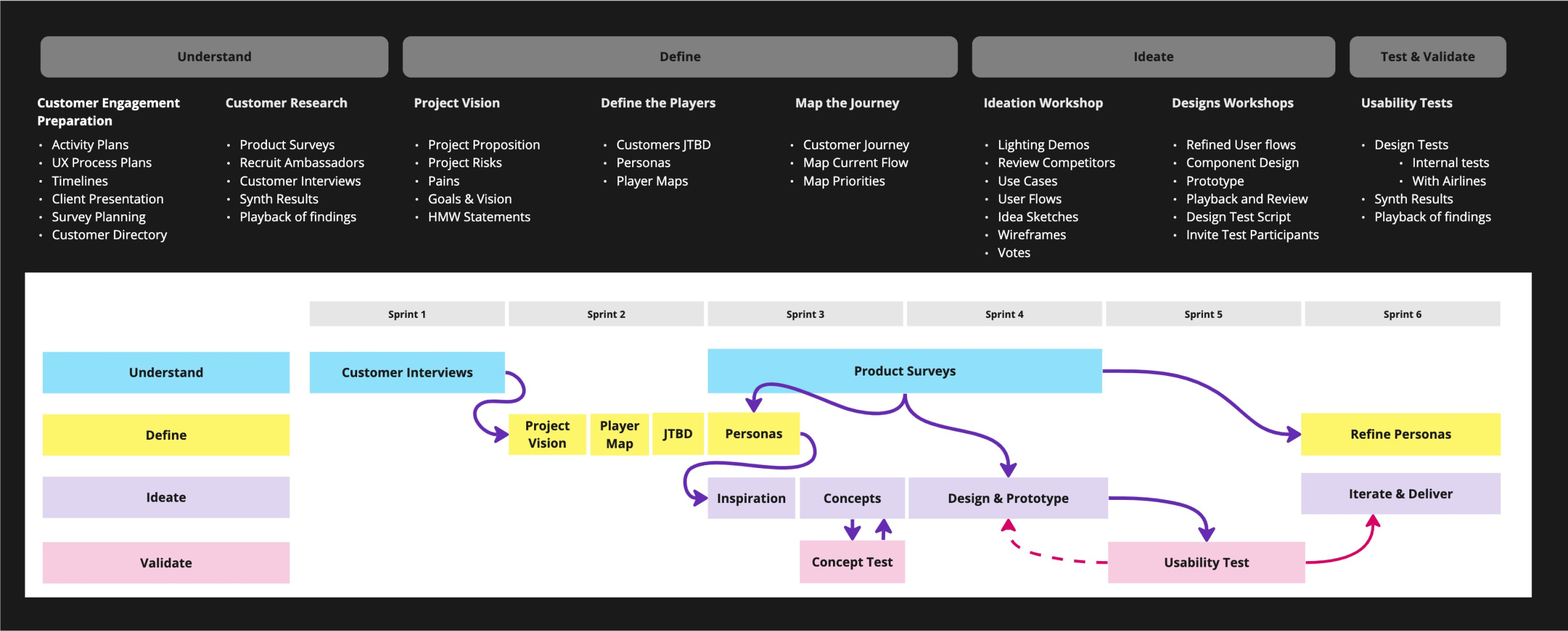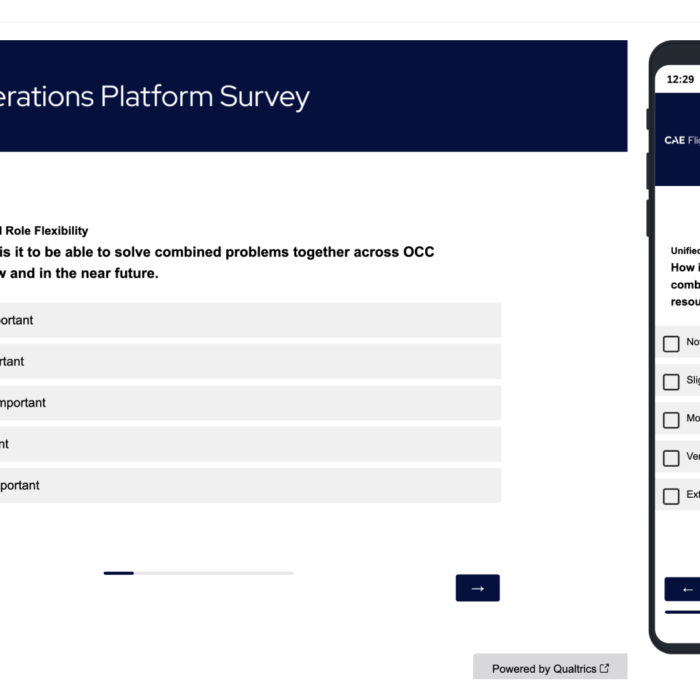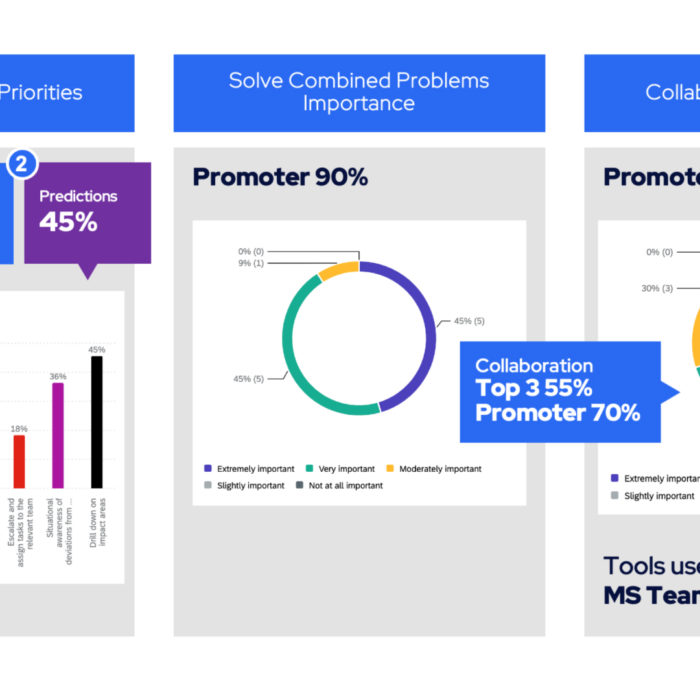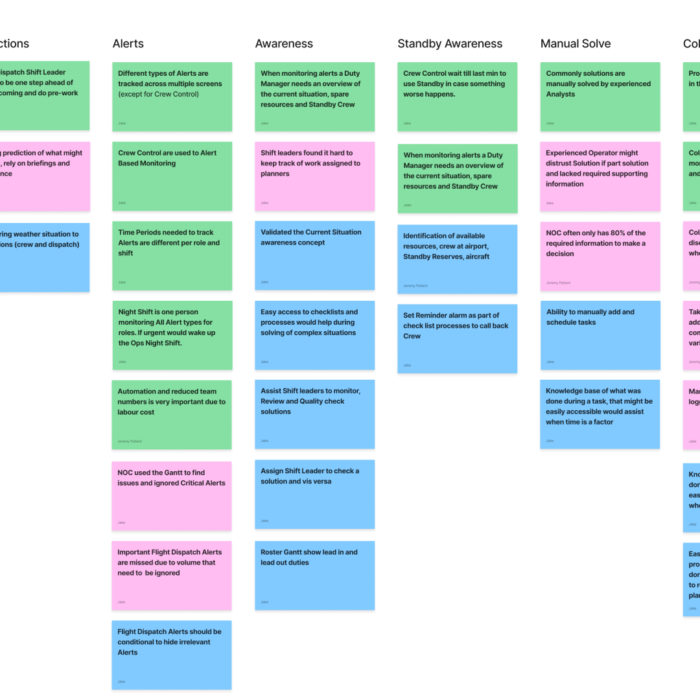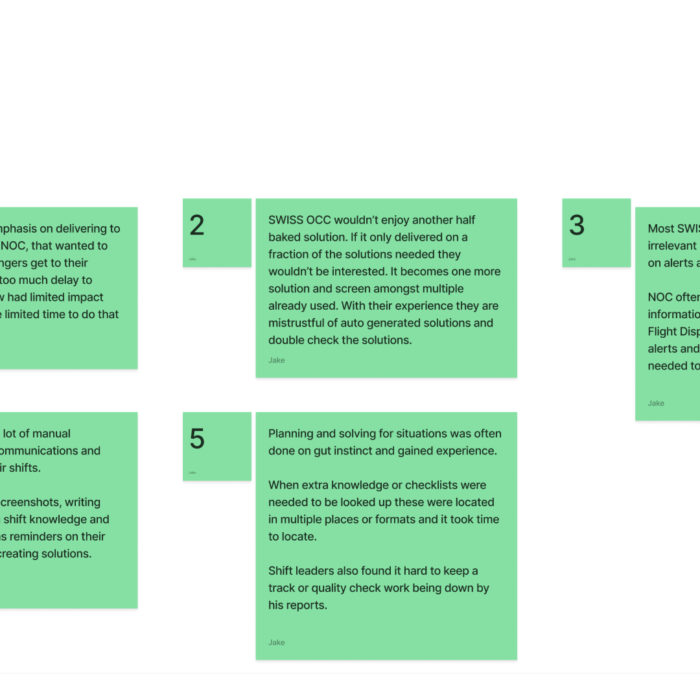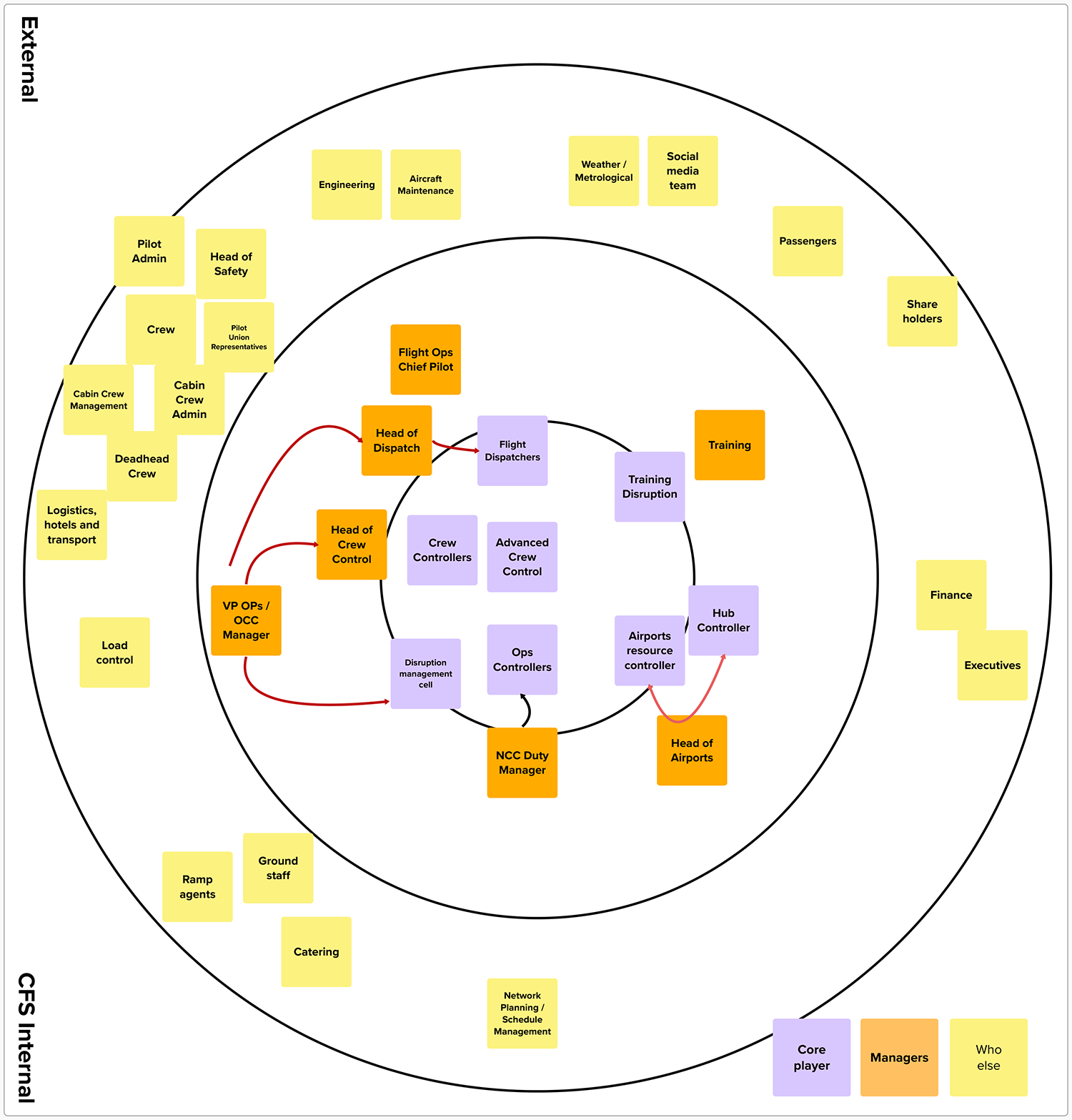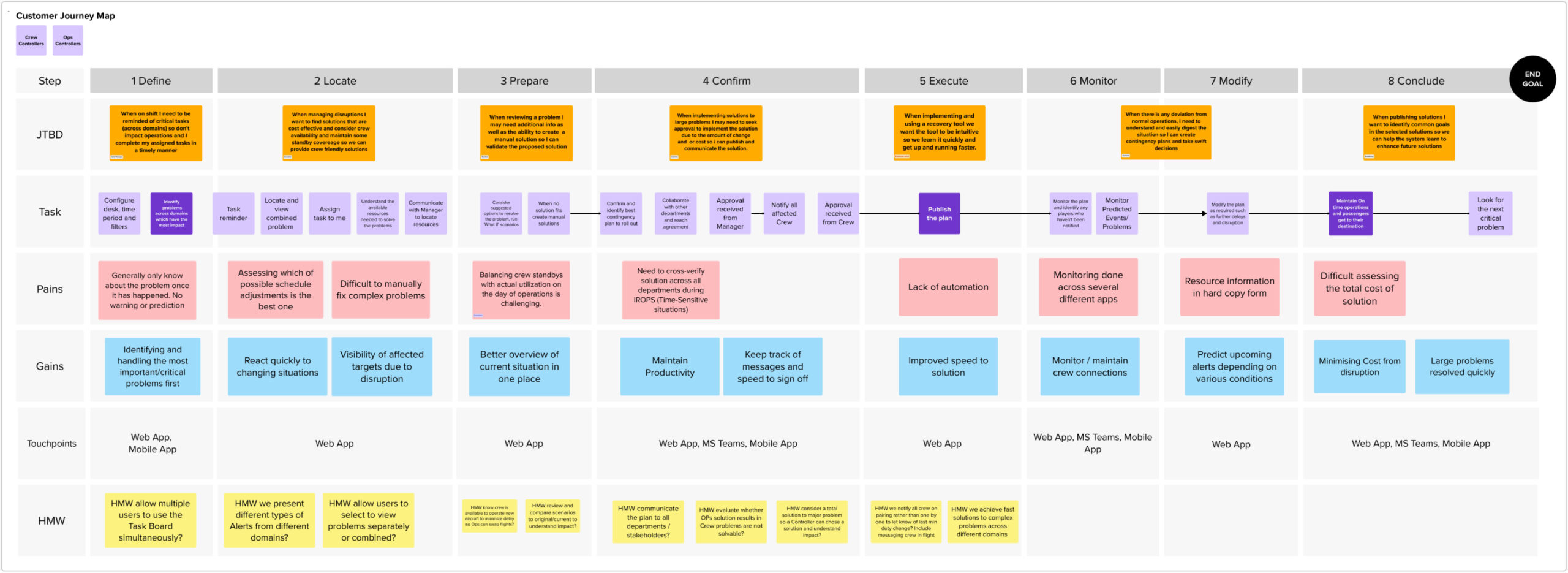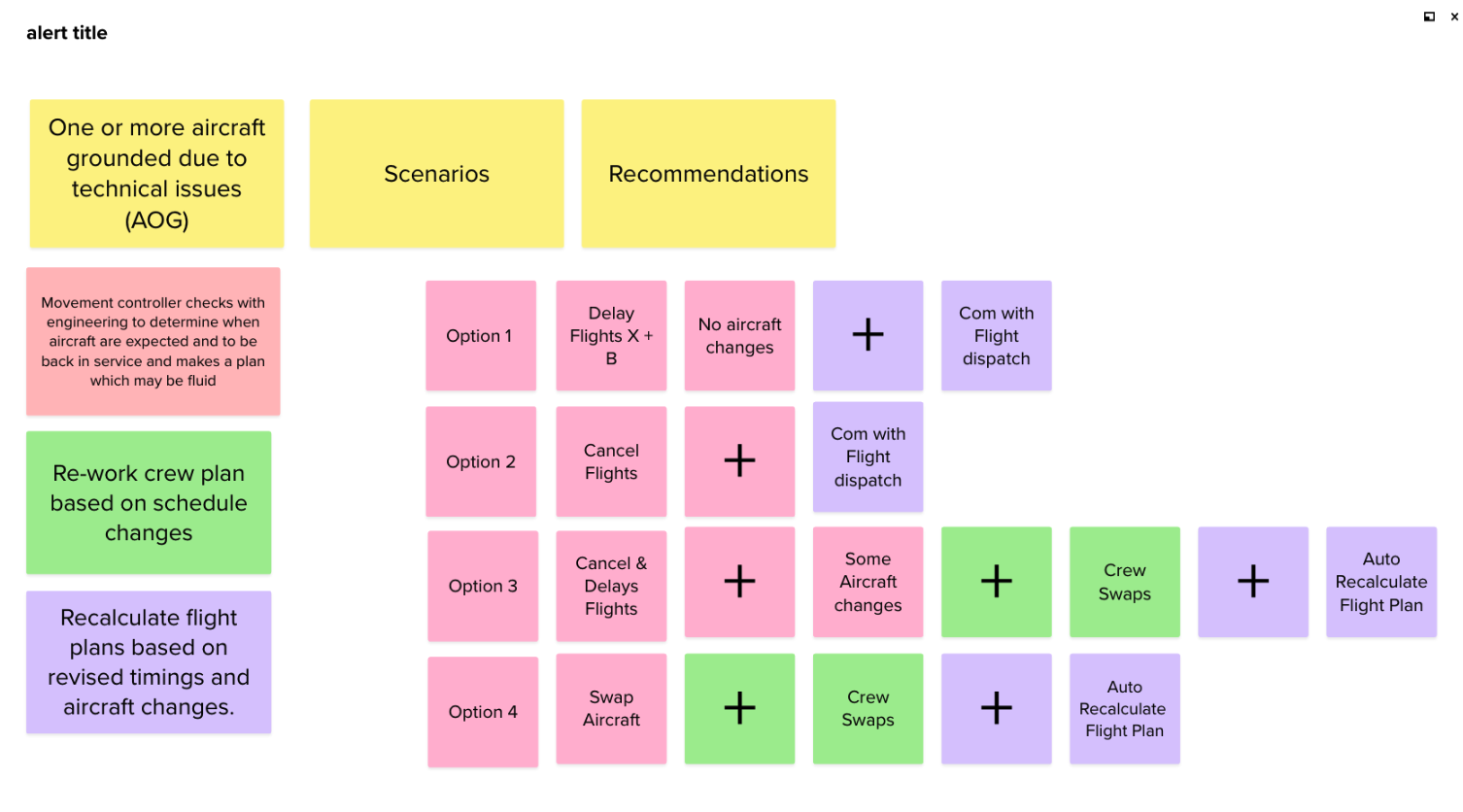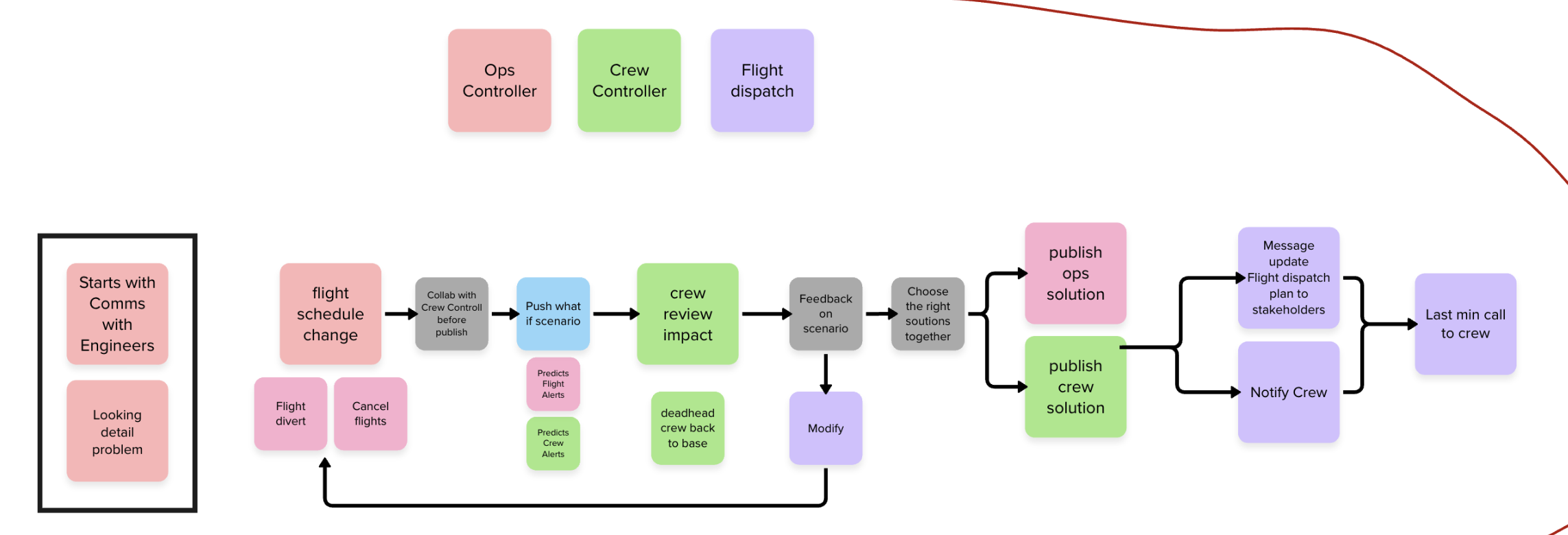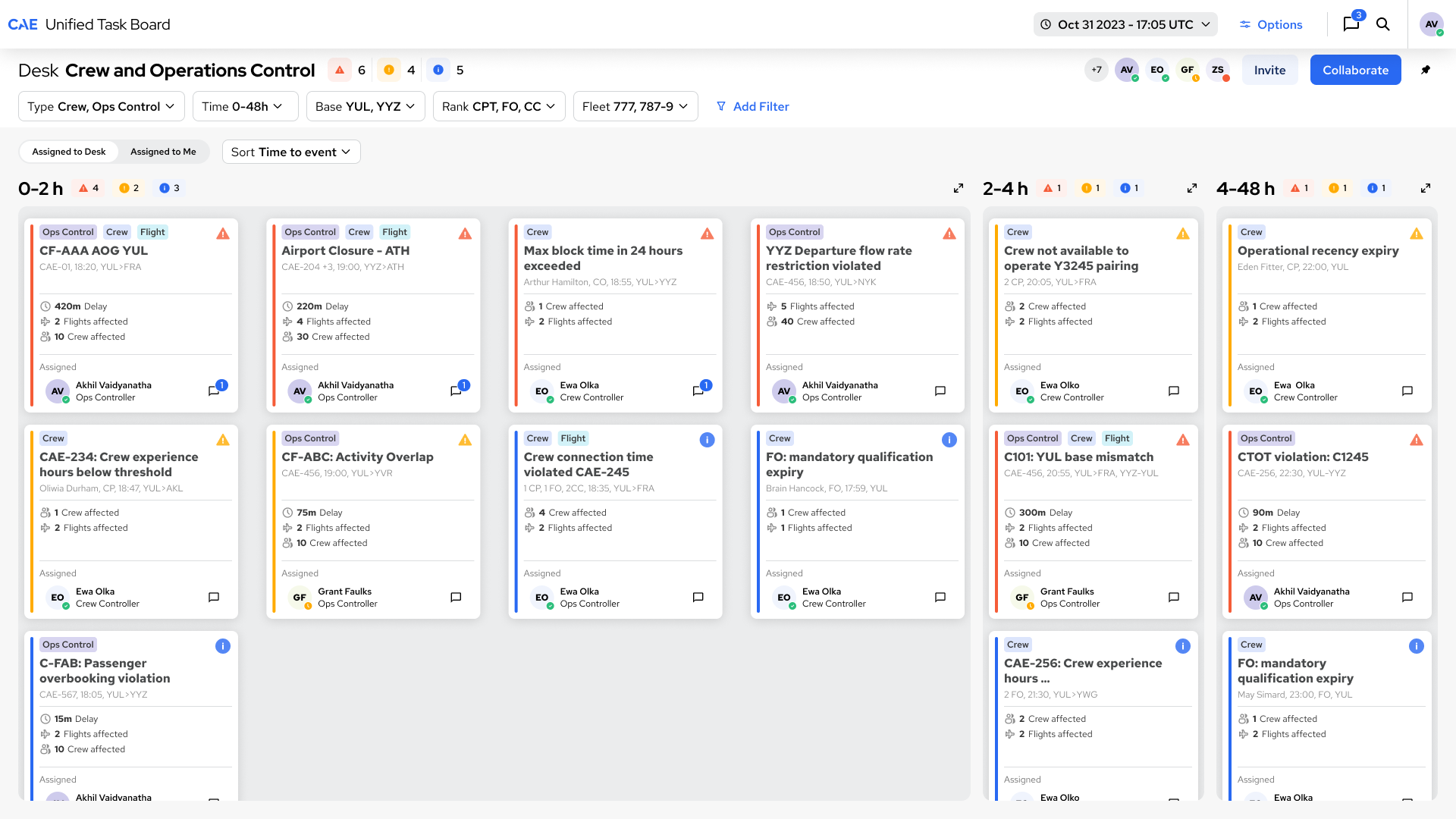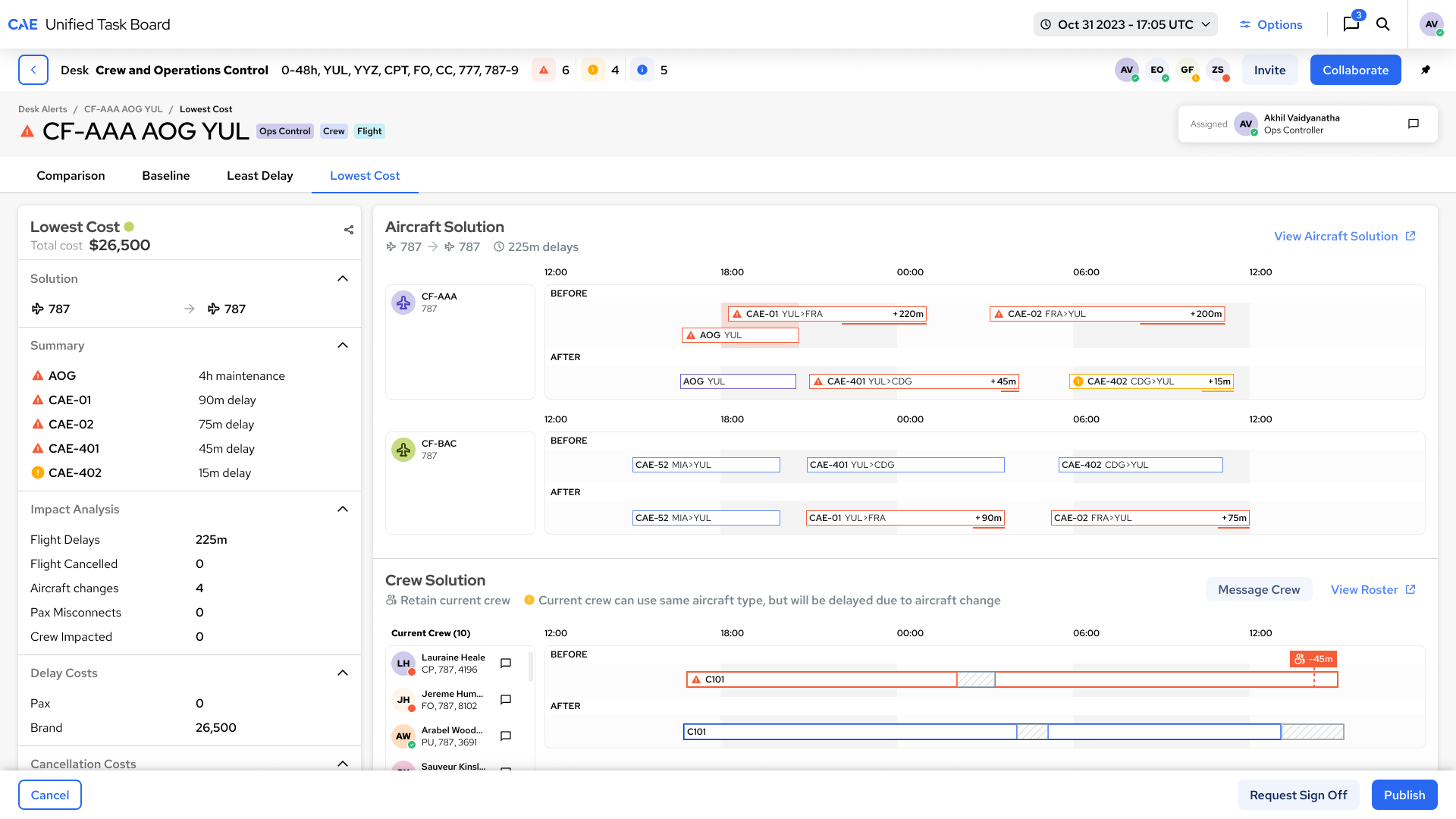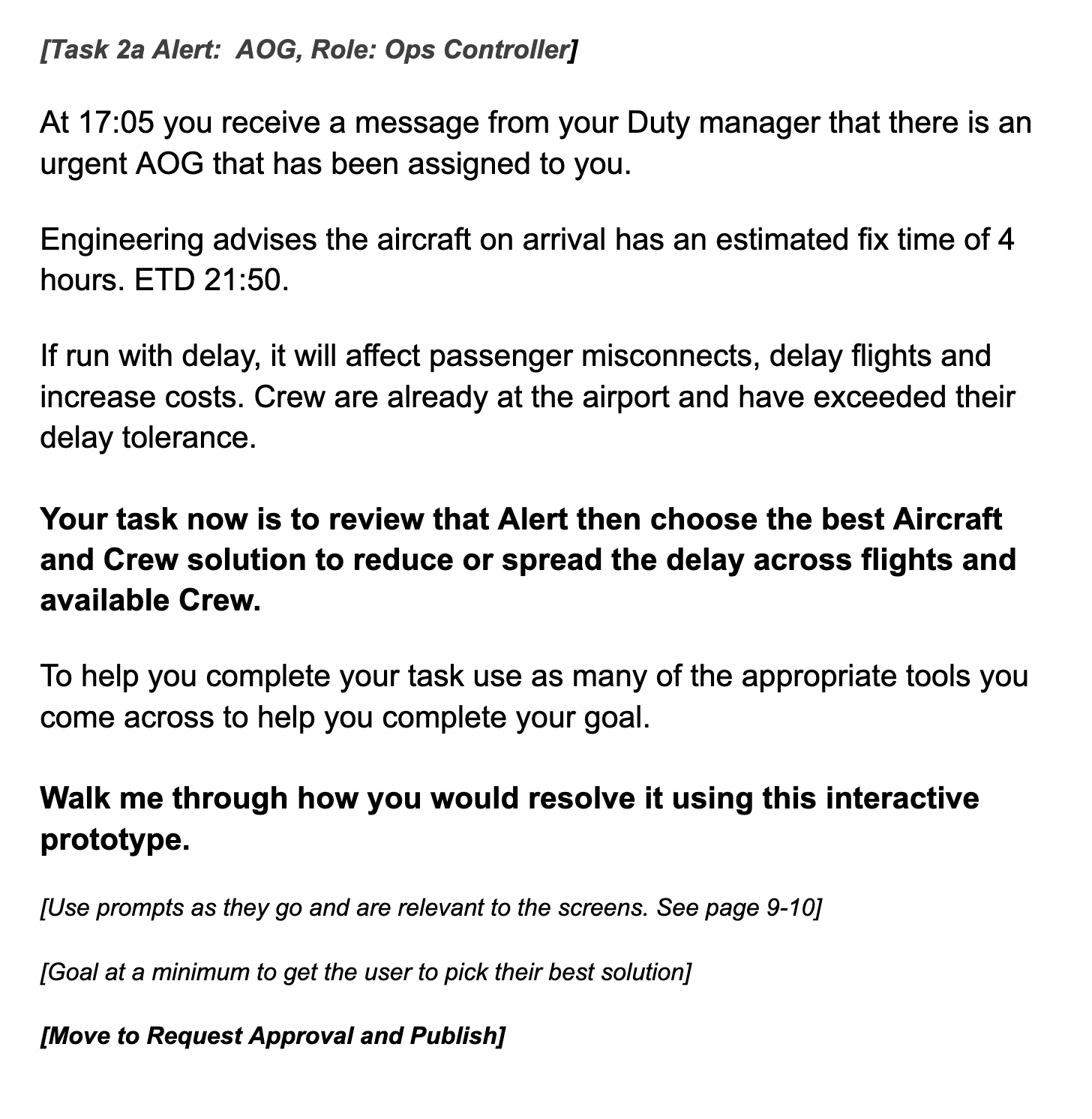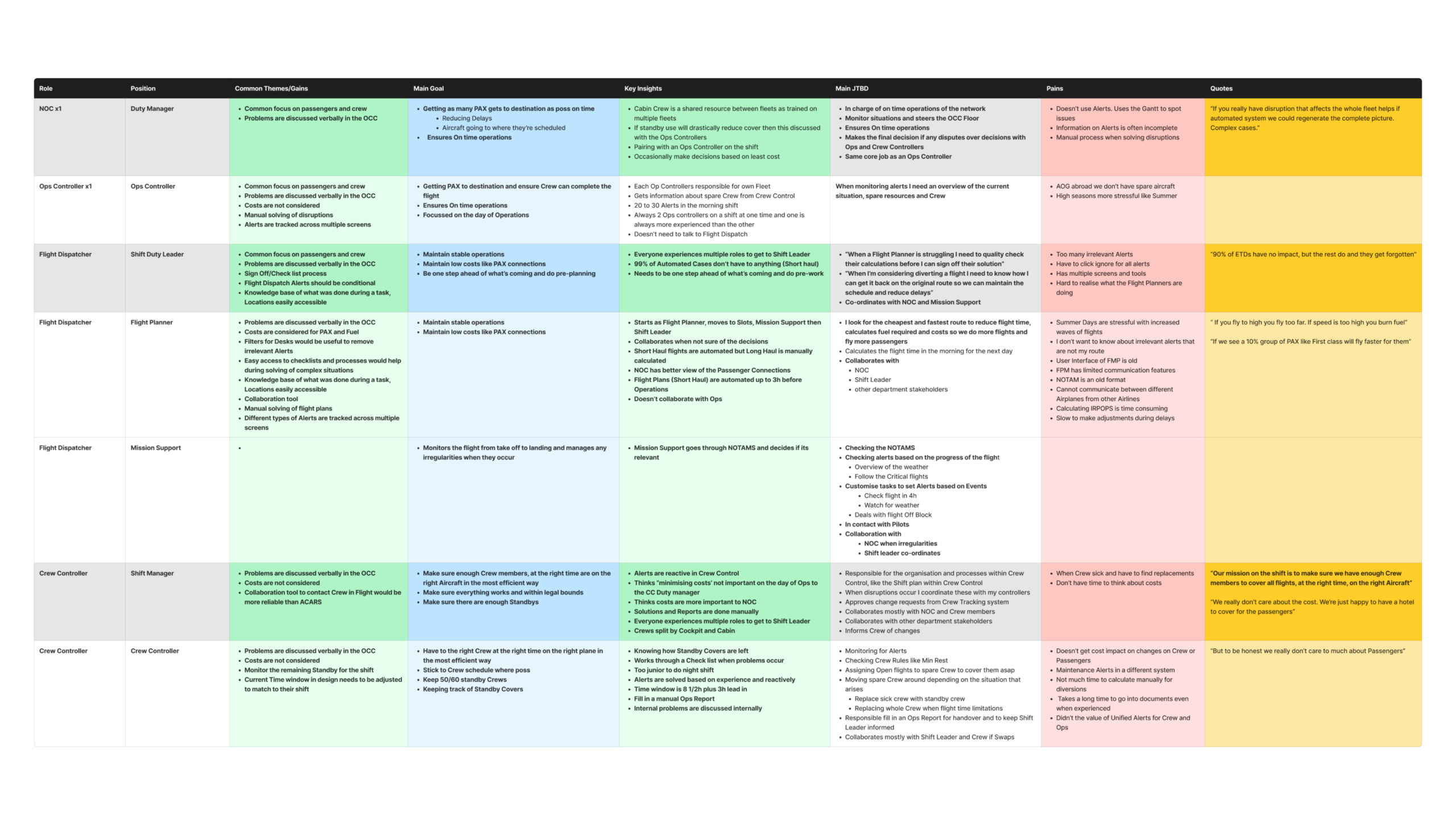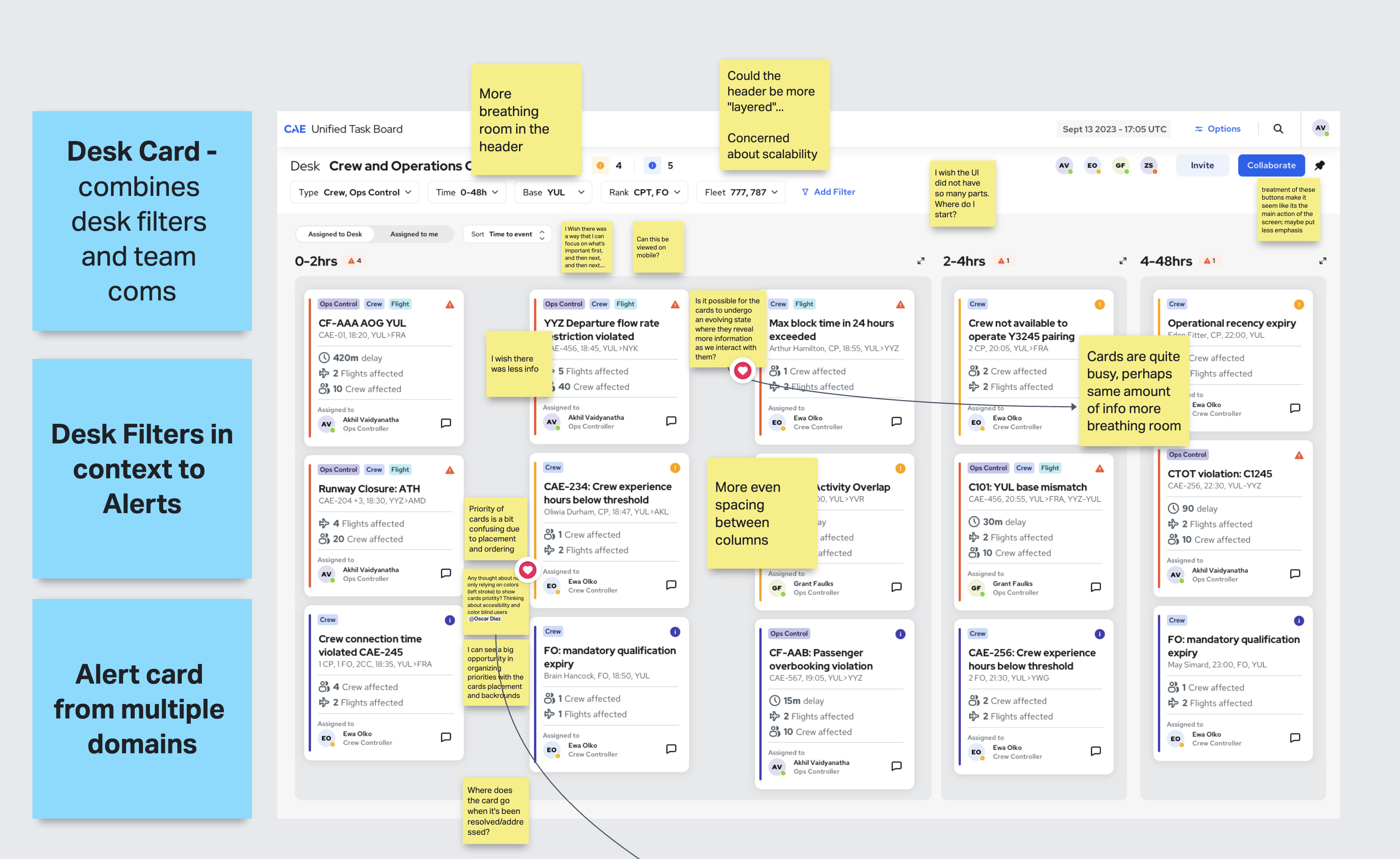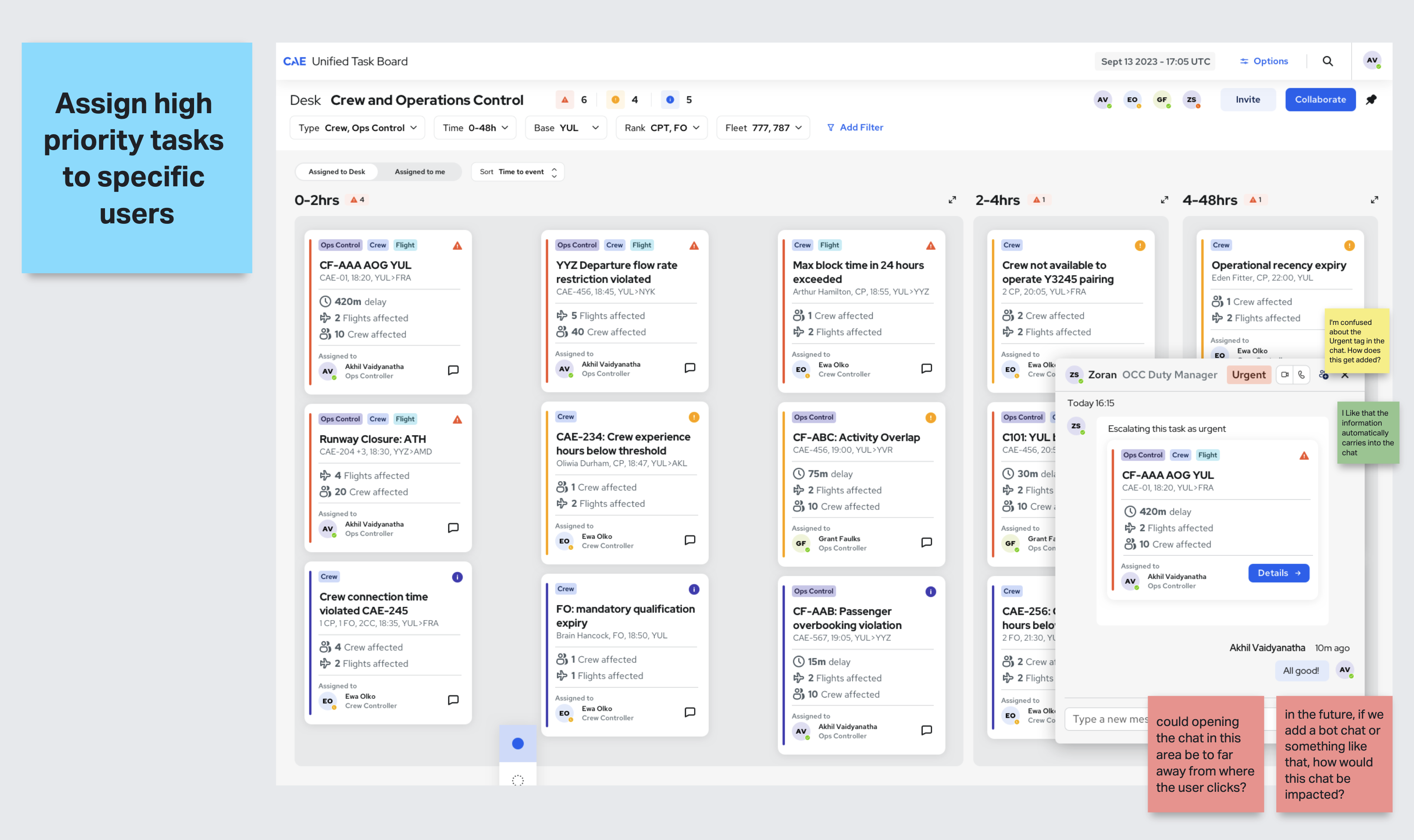CAE Unified Task Board
Unifying Disruption for Civil Flight Services
Project Overview
As the lead UX in the CFS Global Platform team, I was tasked with leading a ‘Discovery Design Sprint’ on unifying disruption management for an OCC (Operations Control Centre)* during the day of an Airlines Operations.
*Note: OCC not to be mistaken for Traffic Control Towers. Imagine a big room with lots of screens and data flowing across them. Think Mission Control at NASA, but on a smaller scale.
Project Demo
Project Goals
The project focused on how we might create support for disruptions caused by Aircraft issues, Crew Sickness or Flight Delays. How we might identify and solve issues across those domains.
With an overall goal to minimise impact to passengers and reduce operational costs. And a secondary goal to increase collaboration between roles and unify department silos.
Current Pains
Currently recovery plans are solved in separate apps, personas and teams with a disconnect between plans. Sometimes an alert might appear in one system, with little context to the situation. Then would be manually fixed in another.
Operations Controllers were also annoyed about receiving irrelevant alerts and not being able prioritise which to tackle first.
Discovery Design Sprint Process
The Discovery Design Sprint was an unique opportunity for us to start from scratch, and discover hidden gems we hadn’t thought of before proceeding to solutions.
I facilitated a series of remote workshops from the ‘Understand’ ‘Define’, ‘Ideate’ to ‘Test & Validate’ stages. Based loosely on Google Design Sprints or Double Diamond concepts (as shown).
- Understand our Customer needs through Interviews and Products Survey
- Define the core personas needs, customer journeys and priorities
- Ideate collaboratively to create concepts, flows, designs and prototypes
- Validate our assumptions with customers and uncover missing requirements
Understand the Customer
Collaboration Insights
Understanding the Customer needs was undertaken as a team. Customer engagement happened as musch as possible throughout the Discovery process. Namely as part of Interviews, Product Surveys, Player Workshops and the Test & Validate Stage.
Customer Partnerships
- Established partnerships with SWISS Air to set expectations to level of involvement
- Ran through example UX activities and benefits of their participation
Customer Surveys
- With lack of UX at conferences, I conducted surveys to better understand Customers needs and increase engagement
- Recruited CAE Ambassadors for ongoing research
- Ambassadors could be segmented by audience type by Airline, roles, location and size
- Survey Findings helped validate key products and tasks. eg “Collaboration had a 70% Importance
Customer Interviews
- Facilitated Remote Interviews to extract Personas, Business Objectives and discover specific needs
- Targeted questions around example disruptions and how they are resolved
- Goal to understand situations, motivations, and expected outcomes during their shift
Define the Players Workshops
Facilitated remote stakeholder workshops to agree on a problem statement, map the customer's jobs to be done, develop personas, map customer journeys then finally set priorities.
Divide and Conquer
With time zone and availability difficulties, I simplified the workshops into smaller exercises and separate areas of expertise to capture greater detail in a short timeframe.
- Ran the same workshops with two different groups of internal experts, split into Crew & Ops and Flight Dispatch
- With time zone and availability difficulties, simplified the exercises into smaller tasks to capture greater detail in a short timeframe
- If boredom crept in during Workshops, (esp for Dev), introduced Ice Breaker exercises to refocus us back on task
#1. Problem Statement Workshop
Project Vision
"Decision support to help identify and solve disruptions across domains, to keep as close to the operational plan as possible and minimize passenger impact."
Collaboration Insights
This collaboration highlighted current pains, project risks and expected goals of the vision. We used this statement as sort of an elevator pitch and project charter for the team.
Method:
- Brainstormed Current Pains, Risks and Goals of the project
- Collated and grouped into similar categories
- Voted on important statements then refined
- Co-wrote HMW statements (positive statements to how we might create gain or relieve pain).
- Co-wrote a Project Vision
Current Pains
Difficult for an Ops controller to manually fix complex problems under time constraints
Project Risks
Some airlines may not be ready to embrace flexible roles
Desired Outcomes
Task Board will be the one stop shop for surfacing and solving operational problems together
HMW (How Might We)
HMW combine large problems from across domains to solve together in a timely manner?
Collaboration Insights
The Player Map gives us an insight into who will use the product most, and who they might collaborate with to get the job done.
Following the below method we mapped the Core’ Players, Managers and Supporting roles. Then created connections between the players to represent who they collaborate with the most.
Method:
- Listed all the players in an OCC
- Voted on the Core Players then placed those at the center of target
- Next placed Manager roles in the middle, with supporting roles at the outside
- Mapped the collaboration connections
Collaboration Insights
Using a JTBD (Jobs to be Done) framework, we collaborated to create key ‘Personas’ that aligned our vision to Customer needs. We started out brainstorming JTBD Statements then listing out all the pains and gains of a personas daily shift.
Why JTBD?
The JTBD gives us context to the ‘Why, How and What’ of those needs. Whereas a ‘User story’ will often jump straight to a solution. They are often written like this:
“When ‘situation’ I want/need ‘motivation’ so I can ‘outcome’.”
Method:
- Brainstormed Core JTBD, Pains and Gains for each area of focus
- Clustered and refined into core jobs
- Voted on Primary jobs of each persona
- Divided into Personas with key goals, pains and gains
Collaboration Insights
Bringing the vision to life, we mapped the HMW statements, JTBD, Pains and Gains across a timeline from Start to Conclusion.
It gives us a picture of a task flow and touchpoints that might be used on that journey.
The example shown is for an Operations Controller persona.
Method:
- Map each Job to a key stage of a journey from start to end goal
- A task flow describes a possible user interaction
- Followed by Pains, Gains and HMW Statements
- Also considered are key touchpoints
Ideate
Ideation included reviewing inspiration, use cases, user flows, concept wireframes then exploring designs.
#5. Concepts Workshop
Collaboration Insights
The next stage of collaboration jumps in visualsations of uses cases and user flows for our Personas. The userflows examples were more about understanding how the persona might solve those tasks, than interactions at this point.
We came up with two directions:
- Feed of Alert types across domains with roles unified with a Collaboration Tool
- Predicted Big Problems with auto generated machine learning solutions
Example AOG (Aircraft On the Ground) Use Case
“Current time 17:05 UTC (universal coordinated time). Engineering advises that the aircraft planned, a 787 for YUL- FRA is AOG (Aircraft On the Ground) on arrival with an estimated fix time of 4 hours. ETD 21:50.
Crew are already at the airport and have a delay tolerance of 03h 20m which exceeds the delay tolerance of 2 hours.
If run with delay, there are passengers with misconnections in Frankfurt that will require re-booking.
17:05 you receive a chat message from your Duty manager that this alert is now urgent…
As a Operations Controller your task id review the situation and implement the best solution to reduce delays.
“
#6. Design Exploration
Collaboration Insights
Now we delve into the world of Figma…
Persona Prototypes
For testing purposes, I created prototypes for three Personas and use cases.
The examples here look at ‘Operations Controller Persona’ and an ‘AOG: Aircraft on the Ground’ Alert. An aircraft stuck on the ground due to mechanical issues.
Three Personas:
- Shift Manager – Assign, Review & Sign Off
- Ops Controller – Review, Create and Publish
- Crew Controllers – Crew problems
Data by design
- Mixed accurate data into the designs so it maps back to realistic situations and solutions an Ops Controller might expect
- Included creating visual charts or gantts with interactive states
- Key was making sure the metrics were the expected KPI and added up if calculations had been performed
Collaboration Tool Components
- From the importance of collaboration, I designed flows to allow communication, sharing and solution sign off between ‘team and Managers
- Adapted MS Teams design system, as research showed us the use of MS Teams was common at Airlines
Dev Handover
- Ran Feasibility Reviews
- Documented Design in a Jira ticket as I progressed
- Captured Screenshots into the ticket
- Made short demo videos for Remotely located Developers
- Connected and shared Figma designs
Test & Validate
Validating our vision with Customers
Usability Tests
Test Goal
- Validate vision with customers
- Test use cases and how they expect to be resolved
- Test collaboration flows
- Test at least 3 or 5 of each persona
Method
- Wrote test scripts with key tasks and sample questions so as to avoid leading questions which could skew the results
- Invited the team to silently observe and take notes
Test Action
- Ran Remote tests with key personas
- Mixed a prototype test with a Customer interview and feedback survey
- Synthesized those notes in a findings workshop
- Took common patterns of findings, pains or gains
Summary of Results
Interview Findings
-
Collaboration had a 70% importance across all roles from Surveys
-
Ops Controllers were annoyed by irrelevant alerts in current tools
-
Shift leaders found it hard to track direct reports quality of solutions during operations
Action
-
Designed UX flows to allow collaboration and sharing between OCC team members
-
Created a ‘Desk’ concept with set filters to avoid irrelevant alerts for the team and persona
-
Created a Shift-Manager Prototype to assign, track and sign off
Test Learnings
-
Successfully validated the use of MS Teams as a Comms tool during interviews and tests
-
Discovered new learnings and detail about expected alerts and missing information
-
Participants also needed to share knowledge of best practise to resolve issues
-
Discovered Shift manager also needed to track Standby Crew Resource


